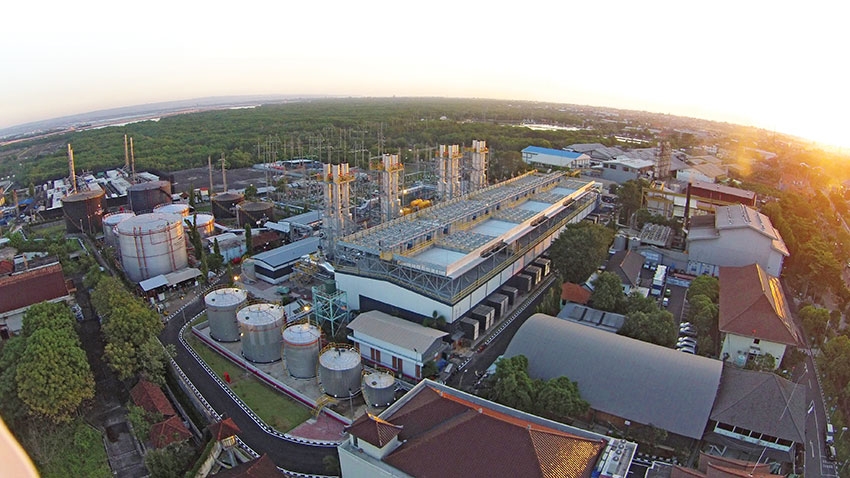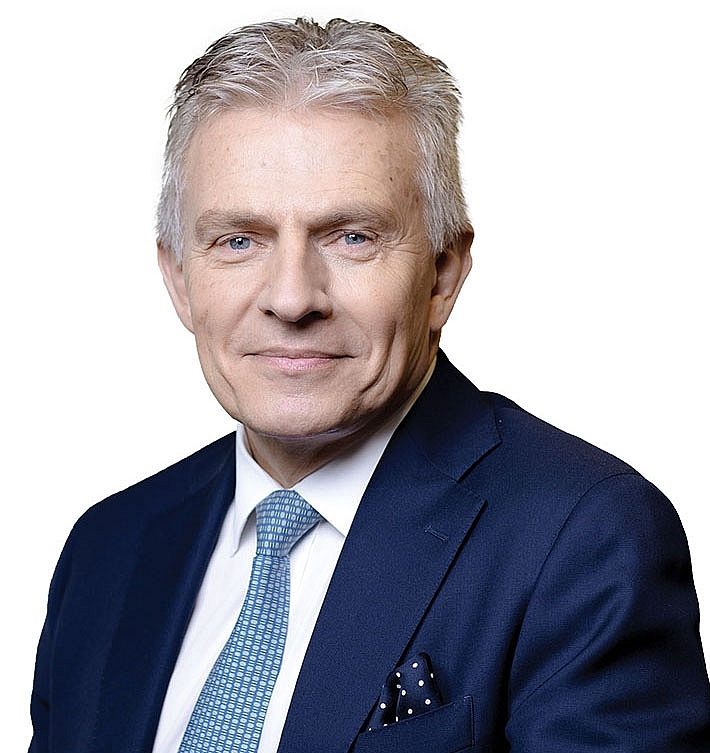Cost reductions possible with Wärtsilä’s expertise
 |
| PLTDG Pesanggaran Bali 200MW plant powered by 12 Wärtsilä 50DF dual-fuel engines |
Wärtsilä is making a call to action, as you believe that the technologies required to achieve a vision of utilising 100 per cent of renewable energy are already available. Can you share Wärtsilä’s vision of what this path will look like?
 |
| Jaakko Eskola |
Wärtsilä strongly believes that the transition towards a 100 per cent renewable future is inevitable, driven both by the need to mitigate climate change impact and the rapidly declining prices of solar photovoltaic (PV) panels and wind turbines.
The pace of this transition may vary from country to country, but the direction is clear. As the penetration of renewable energy increases, the role of traditional baseload generation technologies, such as coal or combined cycle gas turbine (CCGT) plants will decline, due to their inflexibility to cope with the variable nature of renewable energy. It will no longer be economical to run such plants.
On the other hand, investments in flexible forms of generation such as internal combustion engines and energy storage will grow. Ultimately, renewable energy backed up by flexible generation will be the primary source of power, or the base cost solution.
What do you see as the greatest challenges right now in getting there, and do you feel that utilities and nations as a whole are finally getting somewhere?
Renewable energy comes with a high degree of variability and this poses a major challenge to system operators. This is especially so when the existing generation fleet consists of traditional, centralised inflexible plants that were designed for fairly steady, baseload operations.
To absorb renewable energy into an existing grid would require investments in transmission lines to remote sites. To balance the variability and to ensure reliability, investments in newer technologies designed for flexible operations would be required. The resistance or the pushback to renewable energy usually comes from a reluctance to disturb the status quo.
However, many countries are committing themselves to the change, as they realise that the long-term economic rewards will outweigh the short-term pain of transition.
How is this translating into action right now across Asia?
Almost every country in Asia has committed itself to a targeted addition of renewable energy, as a percentage of its overall capacity mix. The figures vary from a modest 5 per cent in some countries to a more ambitious 50 per cent or more in some others, over the next 10-15 years. Countries like China and India are also adding hundreds of gigawatts.
In the initial phase, most countries offer incentives such as feed-in tariffs to developers of renewable energy plants. Vietnam has managed to add an impressive 4,500 megawatts (MW) of solar PV capacity in a very short time, thanks to its attractive tariff. As the price of PV panels keeps coming down, the tariff can be reviewed periodically or can be determined by an auction route.
How can system planners determine the amount of renewable energy generation that can be practically achieved in their system, and how does Wärtsilä help them with this?
To arrive at the country’s optimal capacity mix of the future, conventional planning methods will not be adequate. Sophisticated modelling tools are required to map out various scenarios, and to factor in many variables, constraints, and generation options.
Wärtsilä is a licencee of Plexos modelling software and has carried out modelling exercises in over 70 countries or sub-systems. With the help of these models, planners can take a more informed view of the future scenarios.
The model will recommend the best possible combination of generation options to tap the country’s renewables potential fully and to reduce the total system cost and carbon dioxide emissions, while ensuring 24/7 reliability.
According to research, the potential of renewable energy in Vietnam is high, but many believe that the huge investment costs of equipment and technology is a barrier. What is your view?
Vietnam is blessed with high solar and wind potential, especially in the central and southern regions. Contrary to general belief, investment in renewable energy plants along with flexible generation will actually reduce overall system cost.
Recently, to illustrate the point, Wärtsilä carried out a preliminary modelling of the Vietnam grid for the years 2020-2030, based on certain assumptions of demand growth in each region. We looked at various generation alternatives and compared them with the default option of adding conventional coal and CCGT plants, as envisaged in the Power Development Plan VII (PDP).
The Plexos modelling software recommended the doubling of solar PV addition compared to what has been targeted in the PDP, and to replace part of the planned addition of coal and CCGT plants, with more flexible technology options such as rapid-response engines. The overall system cost was seen to reduce by 12 per cent.
The cost reduction happens because there is an addition of cheaper renewable energy, the fuel consumption is lower, and the higher maintenance costs due to cycling of coal and CCGT plants are avoided. That is why it is important to take an overall system-level view.
Vietnam, with its vibrant economy, will see a good growth in power demand for many years, and will need to add much more generation capacity in quick time. Unlike many developed countries which invested in inflexible technologies and soon found them uneconomical, Vietnam can make the course correction now and leapfrog into a high-renewables future.
What are the solutions you can offer here in order to move towards more flexible and sustainable energy systems?
Wärtsilä offers a complete range of flexible solutions that would bring enormous benefits to Vietnam. Our modular plants, based on internal combustion engine technology and multiple fuel options, can be constructed in 12 months, and we can help Vietnam overcome the expected power shortage in 2021.
These plants can be offered up to a capacity of 600MW or more. They can be started and ramped-up to full load in less than five minutes and stopped instantly when not needed. They can be run at any plant load at the best efficiency. These features are very useful when tackling the unpredictability of renewable energy and are not found in conventional coal and CCGT plants.
Wärtsilä also offers battery storage solutions, standalone or as a hybrid with engines and renewables. We also offer the best software to integrate all these different technologies in the most efficient manner, and we support all our plants with services throughout their lifetime.
We believe that Wärtsilä’s solutions and services will add great value to Vietnam in the coming years and will enable its transformation into a high-renewables grid.
What the stars mean:
★ Poor ★ ★ Promising ★★★ Good ★★★★ Very good ★★★★★ Exceptional
Related Contents
Latest News
More News
- Schaeffler reports strong early output from Dong Nai solar project (December 12, 2025 | 15:16)
- Forestry conference highlights biodiversity and sustainability goals (December 09, 2025 | 13:35)
- Home Credit honoured among top 10 sustainable companies in trade and services (December 09, 2025 | 12:18)
- SCG and seven member companies honoured in Top 100 Sustainable Businesses 2025 (December 08, 2025 | 09:00)
- Nestlé Vietnam pioneers sustainable development and promotes business connections (December 06, 2025 | 12:09)
- CSI 2025 highlights rise of Vietnam’s green champions (December 06, 2025 | 09:00)
- Acecook Vietnam named among top 100 sustainable businesses (December 06, 2025 | 08:00)
- Vietnam’s forest carbon credits draw global interest (December 05, 2025 | 17:41)
- Coro Energy to launch BESS Pilot in Vietnam (December 04, 2025 | 15:12)
- Vietnam strengthens energy storage pathway (December 04, 2025 | 15:05)

 Tag:
Tag:



















 Mobile Version
Mobile Version